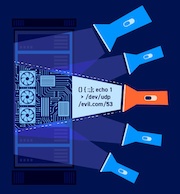Identify a target endpoint
-
In Burp's browser, log in to the application using the credentials
wiener:peter. -
Notice that the response contains your API key.
Investigate path delimiter discrepancies
-
In Proxy > HTTP history, right-click the
GET /my-accountrequest and select Send to Repeater. -
Go to the Repeater tab. Change the path to
/my-account/abc, then send the request. Notice the404 Not Foundresponse. This indicates that the origin server doesn't abstract the path to/my-account. -
Change the path to
/my-accountabc, then send the request. Notice that this returns a404 Not Foundresponse with no evidence of caching. -
Right-click the message and select Send to Intruder.
-
Go to the Intruder tab. Make sure that Sniper attack is selected and add a payload position after
/my-accountas follows:/my-account§§abc. -
In the Payloads side panel, under Payload configuration, add a list of characters that may be used as delimiters. Under Payload encoding, deselect URL-encode these characters.
-
Click Start attack. The attack runs in a new window.
-
When the attack finishes, sort the results by Status code. Notice that only the
?character receives a200response with your API key. This indicates that the origin server only uses?as a path delimiter. As?is generally universally used as a path delimiter, move on to investigate normalization discrepancies.
Investigate normalization discrepancies
-
In Repeater, remove the arbitrary
abcstring and add an arbitrary directory followed by an encoded dot-segment to the start of the original path. For example,/aaa/..%2fmy-account. -
Send the request. Notice that this receives a
200response with your API key. This indicates that the origin server decodes and resolves the dot-segment, interpreting the URL path as/my-account. -
In Proxy > HTTP history, notice that the paths for static resources all start with the directory prefix
/resources. Notice that responses to requests with the/resourcesprefix show evidence of caching. -
Right-click a request with the prefix
/resourcesand select Send to Repeater. -
In Repeater, add an encoded dot-segment after the
/resourcespath prefix, such as/resources/..%2fYOUR-RESOURCE. -
Send the request. Notice that the
404response contains theX-Cache: missheader. -
Resend the request. Notice that the value of the
X-Cacheheader changes tohit. This may indicate that the cache doesn't decode or resolve the dot-segment and has a cache rule based on the/resourcesprefix. To confirm this, you'll need to conduct further testing. It's still possible that the response is being cached due to a different cache rule. -
Modify the URL path after
/resourcesto a arbitrary string as follows:/resources/aaa. Send the request. Notice that the404response contains theX-Cache: missheader. -
Resend the request. Notice that the value of the
X-Cacheheader changes tohit. This confirms that there is a static directory cache rule based on the/resourcesprefix.
Craft an exploit
-
Go to the Repeater tab that contains the
/aaa/..%2fmy-accountrequest. Attempt to construct an exploit as follows:/resources/..%2fmy-account. Send the request. Notice that this receives a200response with your API key and theX-Cache: missheader. -
Resend the request and notice that the value of the
X-Cacheheader updates tohit. -
In Burp's browser, click Go to exploit server.
-
In the Body section, craft an exploit that navigates the victim user
carlosto a malicious URL. Make sure to add an arbitrary parameter as a cache buster, so the victim doesn't receive your previously cached response:<script>document.location="https://YOUR-LAB-ID.web-security-academy.net/resources/..%2fmy-account?wcd"</script> -
Click Deliver exploit to victim. When the victim views the exploit, the response they receive is stored in the cache.
-
Go to the URL that you delivered to
carlosin your exploit:https://YOUR-LAB-ID.web-security-academy.net/resources/..%2fmy-account?wcd -
Notice that the response includes the API key for the user
carlos. Copy this. -
Click Submit solution, then submit the API key for
carlosto solve the lab.


